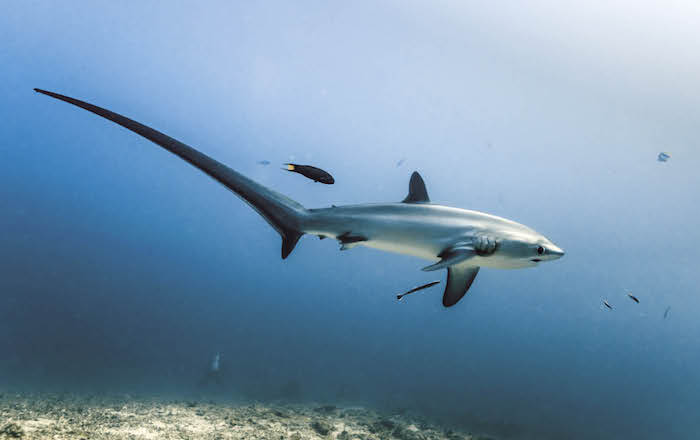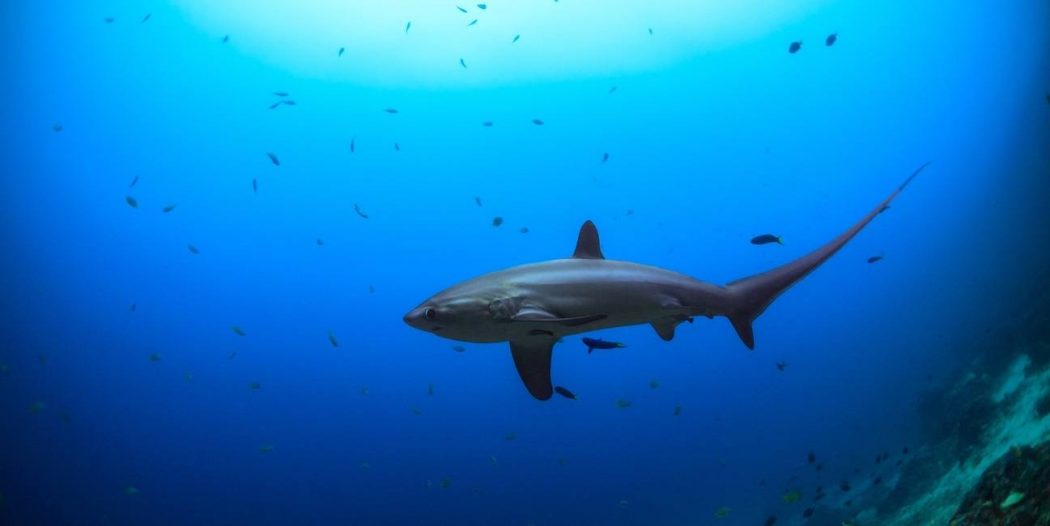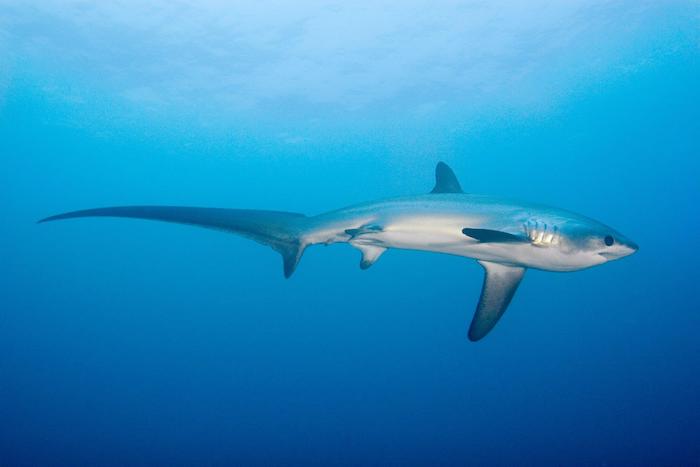Did you know that we see thresher sharks in Puerto Galera? How much do you know about threshers sharks and do you know why a sighting of a thresher shark is so special?
Of course, diving with thresher sharks is on most divers’ bucket lists but we guarantee you’ll have an even better underwater experience if you know a little bit about these amazing sharks before you dive with them – read on to find out more!

Thresher shark: free swimming
How to Identify a Thresher Shark?
Thresher sharks are also known as fox sharks and they are easily recognizable by their long and highly distinctive thresher-like tails which can be just as long as the shark’s body. Thresher sharks also have unusually large eyes in order to help them to see in deep water where less light is available. When in shallow water however, their eyes become sensitive from too much light which is why they usually remain deep and are rarely seen by divers on a regular basis. The sightings we have of thresher sharks, at recreational diving depths, at Puerto Galera’s dive sites are very unusual and this is why a sighting is very special!
Thresher sharks can grow up to 6 meters long, including their tails and they feed on a diet of schooling fish and squid. Their long tails are not just for decoration – the sharks use them to stun their prey. Thresher sharks circle smaller fish and ‘herd’ them with their tails into a tight, ball formation, which they will then attack with a powerful swipe of their tail – stunning some of the fish which the shark will then feed on.

Dive with thresher sharks in Puerto Galera
Thresher Sharks and Depth
Thresher sharks are generally a deeper dwelling species of shark that spend most of their time below 40 meters. So why then, do they come to the shallower water and dive sites around Puerto Galera? Because of the fish – and not to eat them! Thresher sharks carry parasites on their skin and around their eyes and gills. These parasites do not harm the thresher shark if they are kept in check, however, if they are not regularly cleaned away, the number of parasites will increase and the shark will become unhealthy. Thresher sharks rely on the small reef fish to help them out by ‘cleaning’ them. When the threshers come to the shallow water, the reef fish will feed on the parasites – a free meal for the reef fish in return for some personal grooming for the shark! Because the cleaning process is vital to the health of the sharks it is extremely important that divers do not interrupt this process (see below).
Diving with Thresher Sharks
We hope that we will be seeing thresher sharks in the waters around Puerto Galera for many years to come so it important that they are not scared away by divers. If you see a thresher shark during your dive, please observe the following guidelines!
- Stay calm and control your buoyancy. Try to avoid sudden movements.
- Please do not ‘chase’ the sharks.
- Please do not try to touch the sharks.
- Please do not direct camera flashes or strobes into the thresher sharks eyes – they are extremely sensitive!
- Please always respect our reefs and do not touch, kick or break and corals.
- Leave the dive site as you found it. Please leave behind only bubbles and take away only photos.
- For your own safety, always be aware of your no-decompression time and do not exceed the planned depth or time of your dive.

A small thresher shark swimming in Puerto Galera
Diving in Puerto Galera
While thresher sharks are a definite highlight of diving in Puerto Galera they are not our only highlight! Our reefs are packed with some of the rarest and most unusual critters in the Coral Triangle – if you are a macro underwater photographer, then diving Puerto Galera is for you!
For those who want to learn to dive in Puerto Galera or take an advanced, tech diving or professional level course, we offer the full range of PADI scuba diving courses from beginner to Instructor!
Are you excited to come and join us for scuba diving in the Philippines? Our friendly team are as passionate about diving as you are and there’s nothing we love more than sharing our reefs and marine life with like-minded divers from around the world!
For more information or to make a reservation, fill in our online contact form or email us at: admin@asiadivers.com/cnt and we’ll get right back to you.
We look forward to scuba diving in the Philippines with you soon!










